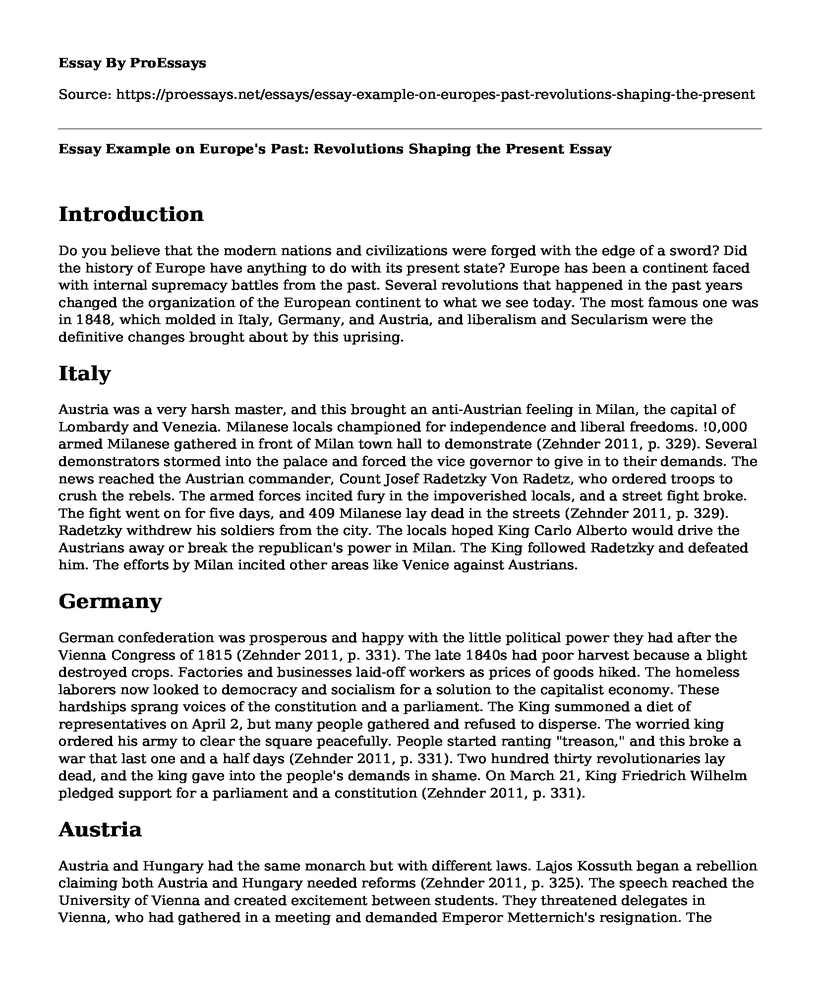Introduction
Do you believe that the modern nations and civilizations were forged with the edge of a sword? Did the history of Europe have anything to do with its present state? Europe has been a continent faced with internal supremacy battles from the past. Several revolutions that happened in the past years changed the organization of the European continent to what we see today. The most famous one was in 1848, which molded in Italy, Germany, and Austria, and liberalism and Secularism were the definitive changes brought about by this uprising.
Italy
Austria was a very harsh master, and this brought an anti-Austrian feeling in Milan, the capital of Lombardy and Venezia. Milanese locals championed for independence and liberal freedoms. !0,000 armed Milanese gathered in front of Milan town hall to demonstrate (Zehnder 2011, p. 329). Several demonstrators stormed into the palace and forced the vice governor to give in to their demands. The news reached the Austrian commander, Count Josef Radetzky Von Radetz, who ordered troops to crush the rebels. The armed forces incited fury in the impoverished locals, and a street fight broke. The fight went on for five days, and 409 Milanese lay dead in the streets (Zehnder 2011, p. 329). Radetzky withdrew his soldiers from the city. The locals hoped King Carlo Alberto would drive the Austrians away or break the republican's power in Milan. The King followed Radetzky and defeated him. The efforts by Milan incited other areas like Venice against Austrians.
Germany
German confederation was prosperous and happy with the little political power they had after the Vienna Congress of 1815 (Zehnder 2011, p. 331). The late 1840s had poor harvest because a blight destroyed crops. Factories and businesses laid-off workers as prices of goods hiked. The homeless laborers now looked to democracy and socialism for a solution to the capitalist economy. These hardships sprang voices of the constitution and a parliament. The King summoned a diet of representatives on April 2, but many people gathered and refused to disperse. The worried king ordered his army to clear the square peacefully. People started ranting "treason," and this broke a war that last one and a half days (Zehnder 2011, p. 331). Two hundred thirty revolutionaries lay dead, and the king gave into the people's demands in shame. On March 21, King Friedrich Wilhelm pledged support for a parliament and a constitution (Zehnder 2011, p. 331).
Austria
Austria and Hungary had the same monarch but with different laws. Lajos Kossuth began a rebellion claiming both Austria and Hungary needed reforms (Zehnder 2011, p. 325). The speech reached the University of Vienna and created excitement between students. They threatened delegates in Vienna, who had gathered in a meeting and demanded Emperor Metternich's resignation. The emperor never took serious the threats until the council of state stood against him. He resigned and fled to England. He said this of his life's work: "If I had to begin my career again, I would follow again the course I took before and would not deviate from it for instance (Zehnder 2011, p. 327)." Revolutionaries wanted a parliament for the entire Austrian Empire. For fear of overthrowing Emperor Ferdinand, the council of state began giving into one revolutionary demand after another. The students formed revolutionary committees that later formed the central committee.
Liberalism and secularism
Liberalism championed for the rights of an individual. The "Forty Eighters" agreed on political stability coming from a constitution, providing a peoples' government, and a guarantee of civil rights (Isakhan, and Stockwell, p. 1-4). This revolution ruined royal absolutism and replaced it with a constitutional and democratic governance system. In Austria, for example, the students formed committees that later established part of the government. The industrial revolution was characterized by religion (Hobsbawm, p. 220). The working-class and urban masses are divided based on religious differences. After the revolution, the exercise of political and civil rights became independent of religious belief. This exercise created equality in the people, and women got a chance to participate in political movements. German democratic societies established their female campaigns. Liberal and secularist revolutions were based on equality as the fundamental fact. These activities drew large numbers of the population into politics despite exclusion from formal political rights and background.
The 1848 revolution shaped Italy, Germany, and Austria through liberalism and secularism. These movements were essential to liberate the people from anarchical systems that oppressed them. This change gave them the liberty to form constitutional and democratic governments that represented their needs. Several people from the lower class were granted an opportunity to lead their fellow peasants. For sure, these actions paved the way for the future of the European continent as a superpower.
Works cited
Hobsbawm, Erick. Libcom.Org, 2020, https://libcom.org/files/Eric%20Hobsbawm%20-%20Age%20Of%20Revolution%201789%20-1848.pdf.
Isakhan, B, and S Stockwell. Eprints.Gla.Ac.Uk, 2020, http://eprints.gla.ac.uk/78871/1/78871.pdf.
Zehnder, Christopher. Light to the Nations, the Making of the Modern World. Ignatius Press, 2011.
Cite this page
Essay Example on Europe's Past: Revolutions Shaping the Present. (2023, Apr 24). Retrieved from https://proessays.net/essays/essay-example-on-europes-past-revolutions-shaping-the-present
If you are the original author of this essay and no longer wish to have it published on the ProEssays website, please click below to request its removal:
- Hungary April 2018 Elections and Viktor Orban Essay
- The Middle East and the Cold War Paper Example
- Essay Sample on America in the 70's
- Essay Example on Nebuchadnezzar's Babylon
- Canada: An Education Superpower - Essay Sample
- Forming Health Policy: A Necessary Step for Healthy Nations - Essay Sample
- Essay Example on Founding Fathers: The Legacy of the Declaration, Constitution, and Danbury Letter







